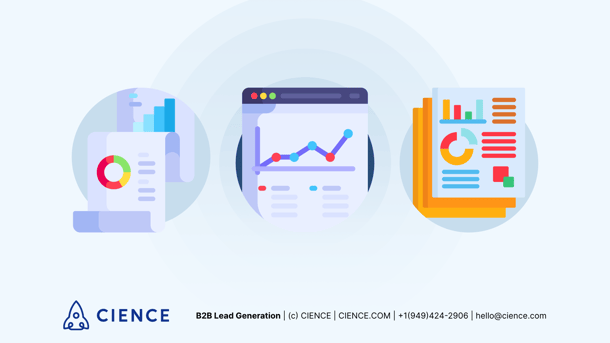Game-Changing Lead Gen Statistics for 2024
Is there a way to find out what the future holds for us? Maybe not in everyday life; however, there is a way to get a glimpse into the future of lead generation, thanks to statistics.
Statistics are as crucial as influencers or thought leaders because they get to speak for the whole industry, define trends, and point out the challenges.
Although, it may be difficult to find fresh B2B lead generation statistics from a reputable source. That’s why we’ve gathered 41 stats from the last couple of years that can help you plan your strategies for the year 2024.
.png?width=688&name=lead_gen_stats_1%20(1).png)
General Lead Generation Statistics
- 34% of businesses say that generating leads is the top marketing goal. Other priorities include attracting more traffic to the website (46%) and increasing brand awareness (45%). (Semrush, 2023)
- B2B companies with mature lead generation processes enjoy 133% more revenue than average companies. (Intellistart, 2021)
- 61% of marketers consider generating traffic and leads to be their biggest challenge. (Hubspot, 2022)
- Over one third (34%) of respondents say prospecting and lead qualification is salespeople's biggest challenge. (Pipedrive, 2020)
- 80% of people prefer to buy from brands whose actions align with their values. (KPMG, 2020)
- The top priority for most marketers (40%) is to generate more leads. (Hubspot, 2021)
- Nurturing leads can increase sales by 50%. (Writer’s Block Live, 2020)
Сontent Lead Generation Statistics
- 45% of marketers say that attracting quality leads with content remains the top challenge, with 38% of businesses struggling to find resources to produce more. (Semrush, 2023).
- 55% of respondents agreed that publishing more content is the big driver of success with it comes to higher rankings organically. (Semrush, 2023)
- B2B blogs with educational content get 52% more organic traffic than B2B blogs with company-focused content. (Backlinko, 2021)
- Only 38% of B2B company blogs publish content to educate their audience. (Backlinko, 2021)
- 80% of B2B companies use content marketing for lead generation. (G2, 2020)
- Blogs (86%), case studies (42%), and customer success stories (36%) are the most popular content formats. (G2, 2020)
- 51% of companies say updating old content has proven the most efficient tactic for their content marketing strategy. (G2, 2020)
- Over 15% of marketers said that lead generation is used as a metric for measuring the success of their content marketing strategy. (HubSpot, 2020)
- B2B companies that blog generate 67% more leads than those who don’t. (Demand Metric, 2019)
Social Media Lead Generation Statistics
- Social media and community building remain the top priority at 52% for marketers. (Semrush, 2023)
- 66% of marketers use social media to generate leads. (G2, 2020)
- Increased exposure, increased traffic, and generated leads are among the top reasons why marketers see value in employing social networks in their campaigns. (Statista, 2021)
- 95% of B2B marketers used LinkedIn in 2020, making it the top B2B social media channel. (Content Marketing Institute, 2020)
- 85.7% of marketers increased their social media activity when the pandemic began. (Statista, 2021)
- 33% of B2B decision makers use LinkedIn to research purchases (HootSuite, 2020)
- Facebook is the most popular social media platform, used by 94% of B2B and B2C marketers. (Statista, 2021)
- Instagram is the social channel with the second-highest ROI among marketers. (HubSpot, 2020)
67% of marketers worldwide say they’ll increase Instagram use in the future. (Statista, 2021)

Email Lead Generation Statistics
- 53% of marketers say email has been the most effective channel for early-stage lead generation. (Demand Gen Report, 2021)
- Less than 20% of marketers utilize subscriber segmentation in their email marketing tactics, with nearly 30% preferring to focus on personalization instead. (HubSpot, 2020)
- Message personalization is the number one tactic used by email marketers to improve performance. (HubSpot, 2020)
- Friday is typically the day with the highest click-through rate potential, at 2.7%. (Campaign Monitor, 2021)
- Companies that A/B test every email see email marketing returns 37% higher than those of brands that never include A/B tests. (Litmus, 2019)
- 35% of people who open an automated email make a purchase compared to 6.75% of those who click on a campaign email. (Omnisend, 2022)
Lead Generation Tools Statistics
32. The leading tools driving content marketing efforts include social media (58%), website analytics (49%), email marketing software (58%), and SEO (43%). (Semrush, 2023)
33. Despite shrinking overall marketing budgets, 26.6% of CMOs say they’ll increase their budget for marketing technology such as automation tools. (Gartner, 2021)
34. 85% of B2B companies use email marketing software to distribute and manage their content. (Content Marketing Institute, 2020)
35. Most marketers use more than five marketing tools daily. (Welcome Software, 2020)
36. 75% of businesses currently use marketing automation tools. (Social Media Today, 2019)
Digital Lead Generation Statistics
37. Short-form videos lead the pack in content performance at 43%, followed by company/product videos (33%) and customer success videos (32%). (Semrush, 2023)
38. Podcasts now reach over 100 million Americans every month. (Edison Research, 2020)
39. 86% of marketers increased brand awareness by using one or more digital marketing channels. (Content Marketing Institute, 2020)
40. About 64% of marketers actively invest time in search engine optimization (SEO). (HubSpot, 2020)
41. More than half (53%) of marketers say webinars are the top-of-the-funnel format that generates the most high-quality leads. (Demand Gen Report, 2021)
Be a Lead Generation Trend Setter
Some things don’t change: Social media is on top of its game, lead generation tools are essential, and prospecting is still a challenge. Perhaps you need to discover a new content marketing strategy? Or create a podcast to promote thought leadership in your industry? Should you adopt video production as a part of your multimedia outreach? Or build your social media team?
Whatever innovation you choose, use these lead generation statistics to help your business move forward in 2024.
